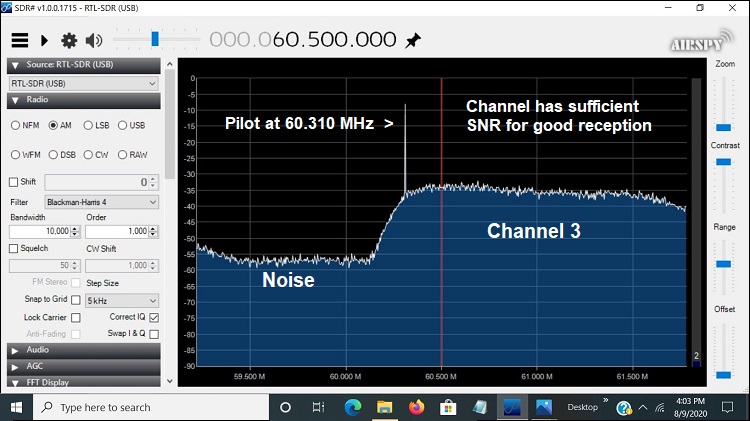Quote:
Originally Posted by rsw1941

Is there ANY chance analog modulation of RF channels back in the late 60s behaved any differently, with regard to ambient noise?
|
Hello, again rsw1941.
Since I don't know your specific concern about ambient noise, I will have to give a general answer.
The ambient noise at any location will reduce the SNR of both analog and digital TV signals.
With analog signals, as the noise level increases, you will see more and more white specks in the picture of VHF signals. As the noise level increases even more, there will be even more white specks until you reach the point where the picture is nothing but snow. The picture never drops out like it does with a digital TV signal.
With a digital TV signal, as the noise increases more errors are created, but the picture quality doesn't change until you reach the "Digital Cliff."

The FEC (Forward Error Correction) corrects the errors, but it has a limited ability. Once that limit is exceeded, the errors increase and you have pixelation, picture freeze, and finally dropout. If there were no FEC, the picture quality would gradually deteriorate, which would be even more annoying than the sudden loss at the cliff.
I have been helping a poster in NJ with low VHF on the satelliteguys forum. I taught him how to use a $25 RTL-SDR.com dongle and SDR# (SDRsharp) software to check the SNR of his signals. I suggest you take a look at that thread:
Low VHF interference
https://www.satelliteguys.us/xen/thr...erence.367781/
The 2020 posts start at post #51


Newer version of software. The display doesn't have to be dark, you can set it to a lighter theme, which I actually prefer. I set it dark to match the scans done by
freeisforme on the satelliteguys forum:

One of these videos should work:
https://www.dropbox.com/s/w62g62arag...02-32.mp4?dl=0
https://www.dropbox.com/s/w62g62arag...02-32.mp4?dl=1
One nice advantage of having an inexpensive spectrum analyzer is when you are doing a channel scan. If a channel doesn't show up, you don't know if it isn't there or just too weak. The spectrum analyzer will give you the answer.


Quote:
|
When installing a mini-CATV system on a 10-acre school campus way back, I vaguely recall using a distribution amp at each building.
|
That is the correct procedure. You want to make the signals stronger before they are split. If you don't, the SNR will be reduced as the signals get weaker. Once the SNR is reduced, you can't get it back.